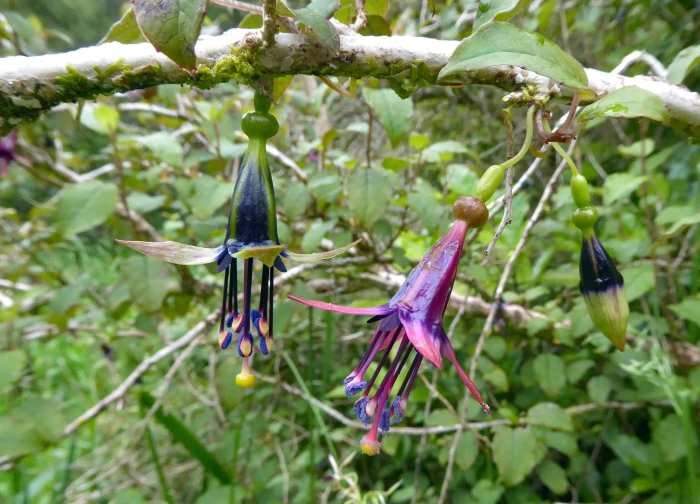Climbing Fuchsia
(Fuchsia perscandens)
Climbing Fuchsia (Fuchsia perscandens)
/
/

Peter de Lange
Public Domain
Image By:
Peter de Lange
Recorded By:
Copyright:
Public Domain
Copyright Notice:
Photo by: Peter de Lange | License Type: Public Domain | License URL: http://creativecommons.org/publicdomain/zero/1.0/ | Rights Holder: Peter de Lange | Publisher: iNaturalist | Date Created: 2017-11-16T09:07:02-08:00 |



















































Estimated Native Range
Climate Requirements for Vaughan, Canada
| This Plant | Your Site | Plant Suitability for Your Location | ||
|---|---|---|---|---|
| • Precipitation | 24" - 162" | 34" | Your precipitation may be insufficient for this plant. Irrigate N" / year. | Irrigate N" / year |
| • High Temp. | 64°F - 77°F | 80°F | Your summers may be too hot for this plant. | Too hot |
| • Low Temp. | 28°F - 45°F | 13°F | Your winter temperatures may be too cold for this plant | Too cold |
This plant should grow well at your location with about N inches per year (Y minutes per month) of irrigation.
Summary
Fuchsia perscandens, commonly known as Climbing Fuchsia, is a climbing shrub that can be either deciduous or semi-evergreen, depending on the climate. It is native to the moist, temperate forests of New Zealand. This species typically grows to a height of 5 feet (1.5 meters) and can spread to a width of 6 feet (1.8 meters). Its growth habit is scrambling, using other vegetation for support. Climbing Fuchsia is notable for its tubular flowers that are a blend of purple, red, and black hues, blooming from late spring to early fall. The flowers are quite showy and attract pollinators such as hummingbirds.
Climbing Fuchsia is valued for its unique flowering habit and is often used in cultivation for trellises, arbors, and as a specimen in woodland gardens. It thrives in part shade, requiring high amounts of water, and prefers moist, well-drained soils with good organic content. While it can tolerate wet conditions, it is important to avoid waterlogged soils. In regions with harsh winters, it may lose its leaves but can resprout in spring. Gardeners should be aware of potential problems such as fuchsia rust and mite infestations, which can be managed with proper care and treatment. This plant is not known for being invasive outside its native range, but it should be monitored to ensure it does not outcompete local flora.CC BY-SA 4.0
Climbing Fuchsia is valued for its unique flowering habit and is often used in cultivation for trellises, arbors, and as a specimen in woodland gardens. It thrives in part shade, requiring high amounts of water, and prefers moist, well-drained soils with good organic content. While it can tolerate wet conditions, it is important to avoid waterlogged soils. In regions with harsh winters, it may lose its leaves but can resprout in spring. Gardeners should be aware of potential problems such as fuchsia rust and mite infestations, which can be managed with proper care and treatment. This plant is not known for being invasive outside its native range, but it should be monitored to ensure it does not outcompete local flora.CC BY-SA 4.0
Plant Description
- Plant Type: Shrubs, Vines
- Height: 2-4 feet
- Width: 3-6 feet
- Growth Rate: Moderate
- Flower Color: Black, Purple, Red
- Flowering Season: Spring, Summer, Fall
- Leaf Retention: Semi-deciduous
Growth Requirements
- Sun: Part Shade
- Water: High
- Drainage: Medium, Slow
Common Uses
Bee Garden, Bird Garden, Butterfly Garden, Hummingbird Garden
Natural Habitat
Moist, temperate forests of New Zealand, particularly in the North Island
Other Names
Common Names:
Scientific Names: Fuchsia perscandens
GBIF Accepted Name: Fuchsia perscandens Cockayne & Allan